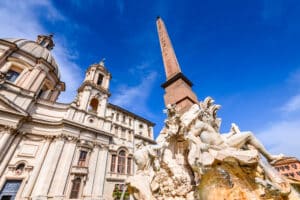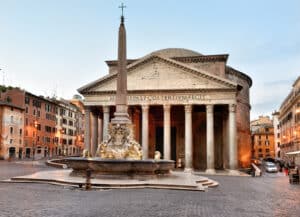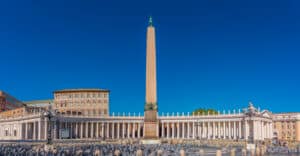Rome, the timeless city, is renowned for its rich history dating back to the foundations of western civilization. However, among the city’s ancient treasures, Egyptian obelisks hold a special place. These monumental structures, originally created by the Egyptians as early as 1600 BC, were later adopted by the Romans in their own urban designs. Today, thirteen of these obelisks stand tall in various locations across Rome, each with its unique story.
In 30 BC, Augustus, the first Roman Emperor, initiated the tradition of importing Egyptian obelisks. The arrival of the first two obelisks sparked a wave of excitement among the Romans. So much so that even the barges that brought them to Rome were put on display. Over time, these obelisks were utilized by the Romans in various ways, particularly by 16th-century popes, who incorporated them in several urban projects.
The relocation of these monumental obelisks was indeed a colossal task. One notable example is St. Peter’s obelisk, which required the combined efforts of nearly 1,000 men, 150 horses, and several cranes for its repositioning.
The Egyptian Obelisks of Rome: A Close Look
Piazza del Popolo
Standing proudly in Piazza del Popolo is an obelisk from the reign of Seti I (1318–1304 BC). This obelisk was one of the first to be brought to Rome by Augustus in 10 BC to adorn the Circus Maximus.
Piazza Navona
The Piazza Navona houses a unique red granite obelisk with 1st-century imitation-Egyptian hieroglyphics. This obelisk was moved here from Circus Maxentius by Innocent X.

Egyptian obelisk in Piazza Navona
Piazza Minerva
This piazza is home to the smallest obelisk in Rome, a 6th-century BC Egyptian red-granite structure. This obelisk originally stood at the nearby Temple of Isis.

Piazza Minerva
Piazza della Trinita dei Monti
Atop the famous Spanish Steps, you can find an obelisk from the 3rd-2nd century BC. Its hieroglyphics were added in Rome and were copied from the obelisk in nearby Piazza del Popolo.

Piazza della Trinita dei Monti – Obelisk
Piazza dell Esquilino and Piazza del Quirinale
These piazzas hold twin obelisks that were originally part of Augustus’ mausoleum. Interestingly, neither of these obelisks have hieroglyphics.
Piazza della Rotunda
The Pantheon square houses a 13th-century BC, red granite monolith from Ramses II. This monolith also decorated the Temple of Isis.

Piazza della Rotonda, Pantheon, Rome
Piazza di Montecitorio
This piazza houses one of the first two obelisks brought to Rome by Augustus, which was used as a giant sundial. This obelisk hails from the reign of Psammetichos II (595–589 BC) at Heliopolis.
St. John Lateran
This location is home to the oldest obelisk in Rome, crafted in 1504–1450 BC. This red granite monolith stands an impressive 105.6 feet tall, making it the tallest obelisk in existence.
Pincio Gardens, on the Piazza Napoleon
This garden houses an obelisk made in Rome by Emperor Hadrian to adorn the funeral monument of his beloved Antinous (2nd century AD).
Villa Celimontana
This residence holds the sister obelisk to the one at the Pantheon. After it fell at the Capitoline Hill, it was repurposed as a step up to S. Maria in Aracoeli.
Piazza dei Cinquecento
This piazza near the train station is home to an Egyptian obelisk discovered near S. Maria Sopra Minerva in the late 1800s.
Piazza San Pietro
This piazza houses a massive obelisk first erected in Alexandria by Augustus. This obelisk was brought to Rome in 37 AD for the Vatican Circus.

Obelisk in Rome – Piazza San Pietro
Modern Obelisks
In addition to these ancient obelisks, you can also find a modern obelisk made from Carrara marble at the Foro Italico. This obelisk was commissioned by Mussolini for a sporting event.
Rome, with its blend of ancient and modern obelisks, offers a fascinating glimpse into the past. These magnificent structures serve as silent witnesses to the city’s rich history and the profound influence of the Egyptian culture on Roman urban design. As you walk through the streets of Rome, remember to look up and appreciate these timeless masterpieces.


Leave a Comment